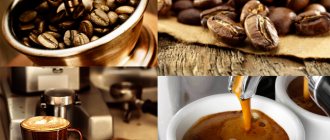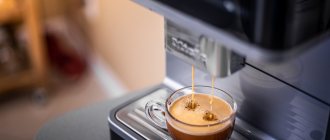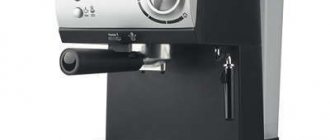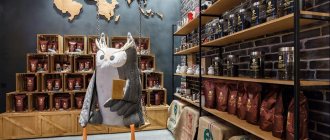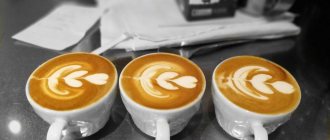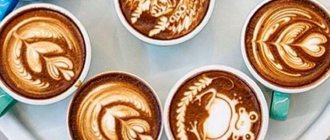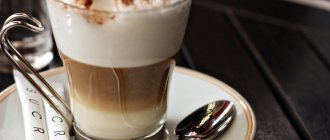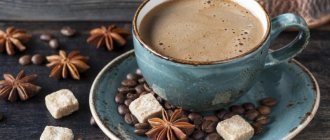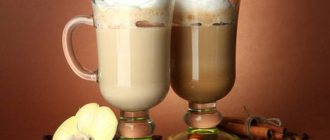Latte art is a technique of drawing a picture on coffee, which is popular in many coffee shops. For a cafe, this is a way to attract visitors, and for a barista, it is a way to hone their skills. However, you don't have to be a professional to know how to make coffee designs. You can learn the art of latte art on your own, the main thing is to be patient.
Historical information
The appearance of latte art is closely connected with the history of espresso, which was invented in Italy at the turn of the 20th century. This coffee drink began to rapidly spread throughout the world. Soon, many cafes began offering espresso with designs.
At the end of the 1980s. American specialist in roasting coffee beans D. Schomer began experimenting with various forms of latte art and in 1989 presented his own method of creating a rosette. Soon he founded an educational course and began teaching those interested in the art of latte art. The new direction quickly spread throughout the United States and the world.
A little about profession and art
In Italy, local residents created a separate coffee culture several centuries ago, but the profession itself - coffee bartender - appeared relatively recently - about 50 years ago. Who is a barista? This is a professional coffee bartender who prepares all types of espresso, including lungo and ristretto, as well as all types of coffee drinks and cocktails (cappuccino, macchiatto, latte and coretto).
How to draw on coffee? A professional barista will answer: “Very simple.” The art of drawing on coffee has appeared quite recently, and in order to master it perfectly, it is not at all necessary to complete a professional bartender course.
Imaging techniques
There are many techniques for applying images to espresso. They all differ in the degree of complexity and the necessary tools.
Pitching
The classic pitching technique involves the use of a special jug with a spout, with which the master draws a pattern with a directed milk stream. The method requires a deep understanding of the fundamental laws of physics, since to create a clear image it is necessary to prepare foam of the correct consistency and select a container of the optimal configuration.
During the drawing process, the master's hand must make quick and confident movements. The formation of this skill occurs as a result of long-term regular practice.
Etching
Etching, or etching, is the creation of a pattern using a pointed object: a stick, skewers, tweezers. Foamed milk is poured onto the surface of the drink, which is then pierced, allowing the coffee to rise out. By combining light and dark spots, baristas create various patterns. Sometimes images are applied using syrups, cinnamon, and chocolate chips.
Etching is creating a pattern using a stick.
Etching is one of the simplest latte art techniques, because when forming a pattern you do not need to use the experience of drawing with milk. The style is used to create illustrations with clear outlines and expressive details. Therefore, a good master must have artistic skills.
Mixed
Classic pitching requires high skill from the barista. When constructing coffee patterns, flaws often appear: asymmetrical arrangement of parts, uneven lines, etc. Such errors often arise when creating complex illustrations. You can correct defects using the etching technique. Therefore, coffee shops almost always combine different methods of drawing.
Stencil
Using a stencil, you can create a beautiful, even pattern without any special skills. Templates are made from cardboard: a vector image is applied to its surface, which is then cut out along the contour. The finished stencil is applied to the edge of a cup of freshly brewed coffee and carefully sprinkled with powdered sugar or cocoa powder, forming a pattern.
Using a stencil you can create a beautiful design.
Volumetric
The 3D technique is a modern way of imprinting that involves using the volume of milk foam and adding variable height to the coffee. Foam can be formed into three-dimensional shapes using etchers.
Engraving
This is one of the most complex methods, which involves the use of a pitcher and other devices to decorate the drink. Its essence comes down to slowly pouring milk onto the surface of a coffee film. At this time, the pitcher should be as close to the espresso as possible.
Engraving is the most difficult method.
Other
There are other decorating techniques:
- Placing, designed to create the basis of the drawing.
- Pushing, which involves making movements in different directions.
- Turbo, which involves using speed to change the contours of shapes.
Does latte art affect the taste of a coffee drink?
It is believed that designs on coffee influence the taste characteristics of the drink. Moreover, with the same ratio of ingredients, the taste of coffee without a pattern feels more balanced. What is this connected with? When preparing a drink with a pattern, a foam ring forms along the edge of the cup, due to which bitterness is felt upon the first sip.
But it is worth noting that experienced baristas have found a way out of this situation - before creating the drawing, they pour a little milk into the espresso, stirring it, and only then proceed to latte art. Thanks to this trick, this very foamy ring turns out to be less concentrated in taste. Due to this, they manage to please the guest with not only a tasty, but also a beautiful drink.
What is needed for latte art: equipment
Depending on the chosen decoration technique, the following tools may be required:
- cappuccino machine, or foamer - a device for whipping foam;
- pitcher, or milk jug - a small jug with a spout;
- a set of etchers - spatulas and rods with thin tips;
- stencils made of cardboard or thin plastic;
- strainer for even distribution of powders.
To create complex, beautiful designs, you need to prepare high-quality espresso and foam of the correct texture. For this purpose, it is recommended to purchase a steam coffee machine with a built-in cappuccino maker.
This device allows you to easily control the temperature and pressure parameters, giving the milk drink the desired properties.
What kind of coffee foam is needed?
Latte art uses microfoam - milk aerated to a dense consistency. Thanks to the presence of small air bubbles, it acquires a velvety surface. In this case, you can obtain stable images with clear, even contours.
Coffee foam has a velvety surface.
The main secret to making high-quality foam is choosing the right milk. It is recommended to choose whole foods with moderate amounts of fat and a high concentration of whey proteins. Protein supports the foaming process.
Drawing on milk foam
As we said earlier, in this case we take milk foam as a basis.
To do this, foam it well. So that the foam gains density. The drawing should remain on it for up to 15 minutes while drinking coffee.
If there are small bubbles on the foam, it means it is whipped correctly. Modern coffee makers allow you to obtain such foam due to high pressure. Moreover, chilled milk of 2-4 degrees is used.
If there is something wrong with the foam, it will be loose with large bubbles. It will not be able to stay on the surface for long and will quickly dissolve in liquid.
How to make a drawing on coffee at home: ideas
There are many options for applying drawings in the latte art style. The basic ones are heart and rose.
Star
Milk foam is poured into a cup of espresso. A circle is drawn on its surface using a pastry syringe filled with chocolate syrup. Using the tip of a thin rod, draw several lines from the center to the edges of the cup, forming long rays. Then they make the same movements in the opposite direction, giving sharpness to the inner corners of the star.
Heart
The image of a heart is the most common and simple example of latte art, with the implementation of which all masters begin their careers.
The heart is a common latte art design.
The pitcher is brought to the edge of the container so that the distance from the spout of the jug to the surface of the espresso does not exceed 10 cm. Milk is poured into the center of the cup until a dense dome-shaped spot is formed.
Then they raise the milk jug a little higher and cross out the white circle with a thin stream, forming the pointed end of the heart.
Apple
A small amount of milk is poured near the wall of the cup and the stream is quickly moved to the center, forming the stem of the apple. Slowly rotating the pitcher's nose draws a circle.
Rosetta
One of the basic elements of latte art is a rosette, shaped like a fern leaf. It's not difficult to draw, but it takes a little more practice and skill than creating a heart.
Rosette resembles a fern leaf.
The espresso cup is tilted slightly. A thin stream of milk is poured into the center so that it sinks slightly below the foamy layer and creates support for the future design. When a large white dot forms on the surface of the drink, the jug begins to slowly rock from side to side and move towards the edge of the container, forming successive semicircular lines. Then they are crossed out with a quick movement, depicting a fern stem.
Bunny
A white spot is formed in the center of the cup - the head of the future bunny. To draw the ears, use the method of creating a previously drawn heart, only the final line is drawn a little faster. Etching is used to create eyes, nose, mouth and mustache.
Secrets of taste
A real barista always has his own secrets for creating unique latte art:
The prepared coffee has its own foam. If you sprinkle cocoa powder on it in a cup, the poured stream of milk foam will turn dark beige.
It is necessary to thoroughly study the behavior of foam when applying drawings. To “pull” the image in the desired direction, you need to sharply draw a line-stream. The height of the milk jug above the cup and the force of the jet are also taken into account. Training sometimes takes months.
Baristas know that the main flavor of coffee is concentrated in the coffee foam. To emphasize perfection, you need to position the drawing correctly. The execution of the classic “heart” allows the coffee foam to stick to the walls. This enhances the aroma and taste of the drink.
Video on the topic
Basic knowledge of latte art
Click Play to view
Making your own coffee stencils
You can make a stencil for decorating coffee at home. Draw a circle on a thin sheet of plastic or cardboard, slightly larger than the diameter of the cup. A simple image is drawn inside, which is then cut out using a knife.
Making stencils is possible at home.
Before first use, wash the coffee stencil in hot soapy water.
Latte Art is another proof that coffee is a real art
When ordering a cup of cappuccino or latte, it is always nice to receive not just a high-quality drink, but some kind of design on it. It makes you smile and really lifts your spirits. No less interesting is watching the barista who makes this drawing. The painting process is very similar to the work of an artist, where every movement and idea of the performer is important.
Photo: instagram.com/26_sverdlova
Sometimes the complexity of a drawing amazes and pleasantly surprises you when you see something unusual and new for yourself. This once again confirms the idea that coffee is an art. It’s not for nothing that most baristas are people who are directly or indirectly connected with creativity. Every day the guys try to move forward and come up with something new to please visitors and improve their skills. Drawings on coffee are like a dialogue between a visitor and a barista. It's always interesting to see people's reactions when they receive the drink. Such things add soul to the drink and the place where you buy it.
To understand the origins of Latte Art, you need to look into the distant past. The first drawings, like the latte drink itself, were invented in Italy. This country has a special relationship with coffee. At that time, baristas began serving cappuccino and lattes with simple designs: “flower,” “apple,” and “heart.” It was these patterns that became the basis for Latte Art. Also one of the popularizers of this art was David Schomer in the 80s-90s. He developed the culture of drawing on coffee in the USA, wrote many articles and published the book “Espresso Coffee. A guide for professionals." All this contributed to the development of coffee culture as a whole.
David Schomer
The main secrets when applying a design to coffee are high-quality coffee, the skill and imagination of the barista, and milk foam. Considering the Latte Art technique itself, we can distinguish several main types of drawing:
- Pouring milk froth into thick espresso is a very simple and practical way to create patterns on the surface of coffee. This technique is the most common nowadays because it produces a fast and durable pattern.
- Obtaining patterns on the surface of milk foam using an etching stick - patterns created in this way are less durable compared to pouring milk foam. Also used for painting caramel and food paints.
- Using Stencils – Coffee designs are created using a stencil and cinnamon or cocoa powder.
In the modern world, the art of drawing on coffee has become very popular. For many years, local and world-level Latte Art barista championships have been held. This encourages participants to come up with more complex designs, use colors and new techniques. So in the spring of 2022, we held the first Latte Art championship in Minsk. This was a very significant event for all the guys who are interested in or professionally involved in making coffee. All participants showed a high level of training and professionalism. This event was a good impetus and incentive for the further development of coffee culture in Belarus.
The winner of the Belarusian Latte Art Championship was Roman Lekhnovich (barista of the “26” coffee shop). He represented our country at the world championship in Budapest. This was a first for our country. And Roma showed a decent level. This proves once again that coffee culture in Belarus is gaining momentum and baristas are becoming truly professionals in their field.
Winner of the national championship Latte Art 2022 – Roman Lekhnovich, coffee shop “26”
To find out the secrets of Latte Art and impressions of the world championship from Roma, our coffenews.by team went to the “26” coffee shop.
Why did you start doing Latte Art? What attracted you to this art?
— Our team is trying to develop in all directions. Everyone supports and guides each other. And with Latte Art it all started a long time ago, when there was no “26” coffee shop. I really liked the glossy foam on the cappuccino and the fascinating designs on it. Latte Art is creativity, where the process depends only on you, your practice and patience. The first drawings came out quite easily. Latte Art started with basic patterns: “heart”, “rosetta” and “tulip”.
What gave the impetus for further development?
— Our national championship, which took place in April, was a big impetus. When the disciplines were announced, I chose Latte Art for myself. At that time I was doing well, but in order to win I needed new ideas. I started preparing in a couple of months. And I realized that it is the preparation for the championship that most stimulates and develops you as a professional. In general, I would like to try myself in other disciplines.
Tell us about the reaction of guests when you bring them coffee with a pattern? Do you often hear compliments?
— The reaction of the guests is obvious. People who drink cappuccino or flat white with us for the first time begin to smile and admire. You always try to come up with something new and interesting. Sometimes it becomes a shame when a drink sits for a long time until a bunch of photos are taken and it becomes covered in “bubbles.” Our guys sometimes joke so that I don’t do my drawings and the guests immediately start eating (laughs).
Share your Latte Art secrets? What needs to be done to get a good drawing?
— First you need to prepare a rich espresso, maybe double. Then the milk comes into play: it is important that it is not too fatty (no more than 3.2%, since fats still hide the taste of espresso from us) and sweet enough (carbohydrates are responsible for this). By the way, warm milk tastes sweeter than cold milk. It's quite simple: initially, the human tongue perceives sweetness better if the product is warm. This explains why cold soda is so refreshing, but when warm it seems cloyingly sweet.
Next, you need to properly aerate the milk (saturate it with oxygen). It is important not to overheat it and make it elastic, glossy, so that it stretches and flows well, without obvious bubbles naturally. And actually pour in the milk, distributing the coffee creams evenly on the surface of the cup to balance the flavor profile of the drink. There are also different spouts for pitchers, which allows you to adjust the flow strength and thickness of the jet. With some it is more convenient to put “dots”, with others “rosettas” and “lines”. Everything is individual and depends on what technique you want to use to make the drawing.
How do you get new drawings? How long does it take to work?
— Nowadays there are a lot of materials on coffee topics on Instagram, especially beautiful drawings on cappuccino. So that's where I mostly find my inspiration. It can take a lot of time to complete a drawing, it all depends on its complexity. But then it’s very nice to see the end result. When you repeat a drawing or make it even better.
Tell us a little about the championship? What is the world level of Latte Art?
— It was difficult for me because of the language barrier, which did not give me the opportunity to communicate with many participants, but Dasha Pinchuk was with us, who helped me with the translation. I’m already starting to improve my level of English, because next year the world championship will be held in Amsterdam. This is a good incentive. Of course, I watched a lot of videos before the trip from previous championships and imagined where I was going. But then I got to know it from the inside. This is a huge gathering of coffee people from all over the globe. A large exhibition where various equipment is presented, coffee machines, coffee grinders, roasters, various types of devices for brewing, green coffee.
There were also many cuppings from the Brazilian laurina to the Panamanian geisha for a thousand dollars. All this gave a lot of knowledge and inspiration for further development. The main things at the Latte Art Championship are the creativity of the drawing and a high level of complexity, for which they give the maximum number of points on the judge’s list. The championship takes place in several stages: one of the first is a performance in the “Art Bar” zone, you are given free rein to your fantasies and the technique of performance is lowered. Only the resulting drawing is evaluated. At this stage, you are allowed to use food coloring. If you combine colors beautifully, you will get a very effective design. It's not that difficult to do, you just need to practice. In normal coffee shop life, you don't use such things.
World Latte Art championship.
Are you going to participate in the championship next year?
- Yes. There are already several ideas for the next championship. I want to show myself again and give 150%. We all have room to strive and grow.
What advice would you give to guys who are just getting acquainted with Latte Art?
- You need to be inspired. It all depends on the product that you should admire, the team you work with, and the conditions created for your development. At 26 we always support and push each other to do something new. This creates the right atmosphere and allows you to work with pleasure.
Secrets of creating drawings
There are several nuances that, if followed, will help improve your drawing skills.
For black coffee
Traditionally, they are painted on a thin, dense layer of milk foam, which serves as a support. However, the pattern can easily be applied to black espresso. To do this, you need to sprinkle the surface of the drink with cocoa powder or cinnamon, after which a pattern is created.
For coffee with milk foam
To apply the design to the coffee film, you need to froth the milk correctly. The foam should be dense and contain microbubbles. Thanks to this, the image can last at least 15 minutes. To achieve this result, you need to beat the product cooled to +3°C.
Professional requirements or what should a coffee bartender be able to do?
An interesting feature: in Italy, most often men become baristas, since latte art requires the greatest skill, honed over the years, but in the domestic restaurant industry, ladies become decorators of coffee cups.
A coffee bartender is not just an attractive appearance and the ability to create simple squiggles. The profession has special requirements that a real barista must fulfill:
- Thoroughly know the rules and techniques for preparing espresso, its varieties and coffee-based drinks.
- Have an excellent understanding of coffee, methods of growing it, varieties and preparation features.
- To have perfect gourmet instincts - to be able to determine the type of coffee from half a sip.
- Be able to prepare the most delicious coffee in the world, as well as draw unimaginable patterns and unsurpassed designs on the foam.
To create a small masterpiece that will disappear with the first sip of the visitor, the master hones his art for hours, or even weeks, tries, experiments and enjoys the amazing result. Understanding how to draw on coffee is not difficult. It is much more difficult to put theory into practice.
Unusual drawings on the foam of the world's best baristas
Over the past 10 years, latte art has been a leading trend in the coffee industry. They are interested in professional baristas who create masterpieces. For example, the Italian artist G. Fiorini depicts realistic images of birds and animals, demonstrating deep anatomical knowledge. And South Korean master Lee Kang Bin uses milk foam to reproduce miniature copies of artists’ paintings from photographs.
Coffee art is an opportunity to show your imagination.
Milk foam painting can be found in coffee shops.
The latte art movement originated in Italy.
Many baristas decorate people's facial features.
You can make a realistic image of a fish.
Many baristas decorate their coffee with images of people with well-drawn facial features and clothing.
Introduction
Today it is difficult to imagine a cappuccino or latte without a design, even the simplest and most uncomplicated one. It has become a matter of principle for baristas around the world to learn how to pour frothed milk into espresso in a way that turns a cup of delicious drink into a work of art. Thanks to training centers and courses, latte art has taken a separate place in the coffee industry. Annual championships make this trend more and more popular, raising the barista’s quality of work and skill to a new level.
Crafts and paintings made from ground coffee - a hobby with an invigorating aroma
If you don't have much time to master complex crafts, try mastering paintings and crafts using ground coffee.
It's simple, flavorful, exciting and very beautiful! Everyone knows that you can create masterpieces from coffee beans, but few have heard that ground coffee is used as a material for creativity. Meanwhile, the aromatic powder is great for complementing other types of needlework, decorating figures made from coffee beans, and for independent use. We have no doubt that you will like crafts and paintings made from ground coffee; even a girl who has never had a penchant for painting can draw them with her own hands.
- Who invented drawing coffee and who needs it
- Paintings from ground coffee: features of the technique and first steps
- Crafts made from ground coffee - simple and fragrant
Who invented drawing coffee and who needs it
Unfortunately, it is unknown who came up with the idea of painting with coffee powder. But this hobby can be put on a par with painting with salt and creating paintings from bulk materials. Perhaps the first coffee painting was given to the world by a coffee lover who did not like the taste of a new type of coffee and decided to dispose of the product in such an original way. However, the world is gradually conquering this fragrant art. Some cities already host drawing competitions, and at crafts fairs it’s easy to buy a painting or panel.
Coffee painting competition
Who is this hobby suitable for? We can safely say that everyone! There are practically no costs, little time is spent, and the result almost always lives up to expectations! For example, it takes several days to embroider a butterfly on a napkin with beads, but creating a coffee masterpiece will take less than an hour!
Paintings from ground coffee: features of the technique and first steps
To draw, you don’t need to buy elite varieties of coffee, which we have already told readers about who are passionate about this invigorating drink. The cheapest finely ground product recommended by the manufacturer for brewing in a cup or Turk will do just fine.
You won’t need brushes to create masterpieces, but you will need to find a drawing stencil, for which a children’s coloring book or the outlines of images on the Internet will be quite suitable. Carefully cut out the image so that after filling the internal space, you get a recognizable and desired motif. To start, take something simple: a butterfly, a leaf, a flower.
Butterfly
Funny bear
Rosette
As a basis for the picture, you can take a board, thick cardboard, glass, or plywood. Select white wallpaper or suitable paper and paste the background onto the base. After this, carefully transfer the stencil onto the paper and cover the places that need to be painted with PVA glue.
Then everything is simple - sprinkle coffee on the glued areas, let the masterpiece dry and blow off the remains. If desired, the picture can be supplemented with whole coffee beans, rhinestones, beads and other suitable elements.
Crafts made from ground coffee - simple and fragrant
Having mastered the simple technique of drawing pictures with ground coffee, you can move on to more complex crafts. Feel free to create panels on fabric, decorate napkins with spectacular designs, decorate dishes, bottles, vases, flower pots, candlesticks, and boxes. Always choose a clear adhesive that is suitable for the base material.
Coffee powder can be used to decorate Easter eggs (real and decorative), topiary balls, which are much easier to make than covering the base with beans, to create stylish valentines, and much more.
Panel on fabric
If nothing comes of drawing and decorating figures, don’t despair. You will definitely get aromatic crafts from ground coffee if you use this delicious raw material to fill miniature soft toys, sachets, and aromatherapy pillows. This useful ingredient can also be used in soap and cream making. As a last resort, you can always recycle coffee powder in the bathroom by preparing an effective body scrub using it.
Be sure to look at the list of all women’s hobbies and choose another hobby for your soul!
Types of latte
Latte macchiato
Latte macchiato uses the same ingredients as a classic latte. Black coffee is brewed in the same way and milk is frothed. The milk is then poured into a glass for Irish coffee. Black coffee is poured into the frothed milk in a thin stream.
The specific gravity of coffee is less than that of milk, so the drink in the glass stratifies: the milk settles to the bottom, the coffee sits above it, and on top there is snow-white foam with a speck of coffee: translated from Italian, macchiato means “stained.” The effectiveness of the speck can be emphasized by sprinkling it with chocolate chips.
Ghetto latte
Black coffee and a glass of whipped milk are served separately. The guest himself selects the proportions of the ingredients.
Cup of coffee with whipped cream
Using a narrow, horizontally oriented oval, draw the top of the cup, as if looking at it from the side.
Below it, draw the cup itself in the form of a semicircle. Draw the handle.
Then draw whipped cream in the form of a “cap” rising above the surface of the cup. Using separate lines, show their loose, voluminous, cloud-like structure.
Outline all the lines of the drawing with a thin black outline. Don't forget to add volume to the handle and thickness to the wall of the mug.
Before you start working with paints, decide which side the light will fall from.
It is fundamentally important that you apply all the necessary shadows realistically
First, work on the area of the drawing where the coffee itself is located. Mix yellow, dark orange and brown colors in it.
Then take the same color mix, dilute it with water and apply the shadows over the cream.
Let the work dry a little. Take the caramel color and apply more saturated shadows to the foam. You will see how the work will immediately “play.”
Use a light gray color to shadow the mug and create a cast shadow on the table.
Dry the work thoroughly again.
Using a thin dark brown outline, draw chocolate chips onto the foam.
A cup of coffee with whipped cream is ready!
We recommend watching:
- How to draw a swan step by step?
- How to draw a raccoon with a pencil
- How to Draw a Portrait for Beginners
- How to draw a lion with a pencil
- How to draw dad
- How to draw a fox with paints step by step?
- How to paint the sea in oils step by step
Technique for creating patterns and images
Latte art, as if on three pillars, stands on three basic design elements, these are:
- heart;
- apple;
- rosetta (rose).
It is imperative to learn how to perform these particular drawings, then other, more complex ones will be easier, because they, as a rule, are a kind of combination of basic techniques, multiplied by the imagination of the performer. Here's how it's done.
Heart: mentally draw a circle on the surface of the coffee and fill it with milk through the spout of the pitcher (it should be directed to the center of the circle), at the final stage the pitcher is raised, the stream is made very thin and the diameter of the circle filled with milk is crossed out with it.
Apple: they begin to draw it from the wall of the cup, depicting a small twig, and then, directing a stream of milk into the center of the cup, they create the fruit itself.
Flower (rosetta): the surface is mentally divided into 4 sectors and first the two upper “quarters” are filled, then, shaking the pinscher slightly, the lower left and lower right are filled, the last portions of milk are poured out in a zigzag motion. They complete the work, as in the case of the heart, by lifting the pitcher and crossing out the picture with a thin stream.
Tulip: this image is based on several hearts, which are crossed by a milky stripe “stem”.
The following video will help you consolidate your skills:
Let's start creating a heart
1-2. We come up with and draw hearts on paper. We cut out and trace the pattern on calico folded in half, leaving seam allowances of 5 mm. Cut with seam allowances.
3. Sew, leaving a 2 cm hole for the upcoming stuffing of the heart. We tie the ends of the threads at the hole. Trim excess fabric along the contour, retreating 5 mm. We make notches on the “roundness” and sharp angle of the tip of the heart so that the fabric does not pull during the upcoming filling of the mold.
4-5. Using a wooden stick, we help you twist out your heart. We go through the corner and roundness with a stick from the inside. With its help, we fill the heart with padding polyester or holofiber. The end result should be a plump, appetizing heart. When you press it, it should simply “spring back.” Sew up the hole with a blind stitch.
6. Prepare a fragrant solution: add z teaspoons of instant coffee to 100 grams of hot water, a pinch of cinnamon and vanilla. Add 1 tbsp. spoon of PVA. Stir well. Apply onto the sachet with a synthetic flat brush, starting from the seams. This must be done quickly, without allowing stains to form.
7. Place 3-4 sheets of writing paper on a baking sheet. Place the wet hearts on top. Place in an oven preheated to 100°C and bake with the door ajar. When our hearts take on the appearance of delicious gingerbread, we take them out of the oven.
8. We decorate the sachet with beads, lace, rhinestones, ribbons, bows. You can drop essential oil of orange, lemon or lavender. Sasha is ready!
Heart for a holiday with a smell
Now it’s clear to you how to make a heart for a romantic evening. The smell of cinnamon brings warmth and comfort to any home, gives relaxed communication, tenderness and tolerance towards people. Promotes an influx of optimism, develops a positive outlook on surrounding phenomena, eliminating the syndrome of acquired lethargy, hypochondria and self-pity.
The cinnamon smell inspires a person to be creative, fills him with a desire to live brightly, intensely and consciously, cherishing every minute of irrevocably passing time. The smell of vanilla gives satisfaction to emotions, makes the heart feel good, encourages confidential communication, and has a calming effect on the nervous system. It is an undeniable afro-disiac. The smell of coffee is a sign of comfort and romance.
Rules for serving latte
Italians drink lattes exclusively in the morning. There are two main options for serving coffee latte and latte macchiato:
- in a tall transparent glass with a straw. However, some foodies argue that plastic ruins the taste of the latte;
- in a glass with a coffee spoon. If you gently stir the foam with it, the drink will acquire a particularly delicate texture. However, the guest will not violate etiquette if he first enjoys the foam with a spoon and then drinks the coffee.
A sugar bowl or sticker of sugar is served along with the latte. Coffee goes well with pastries, jellies, mousses, and desserts with mascarpone.

